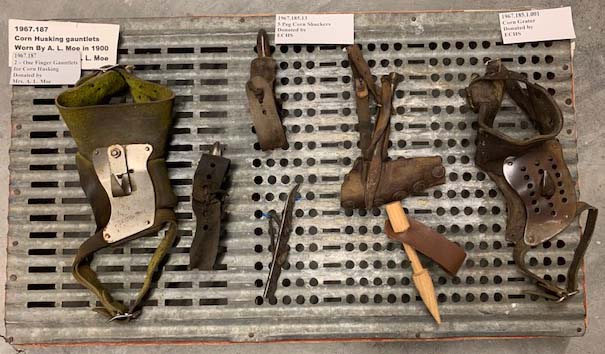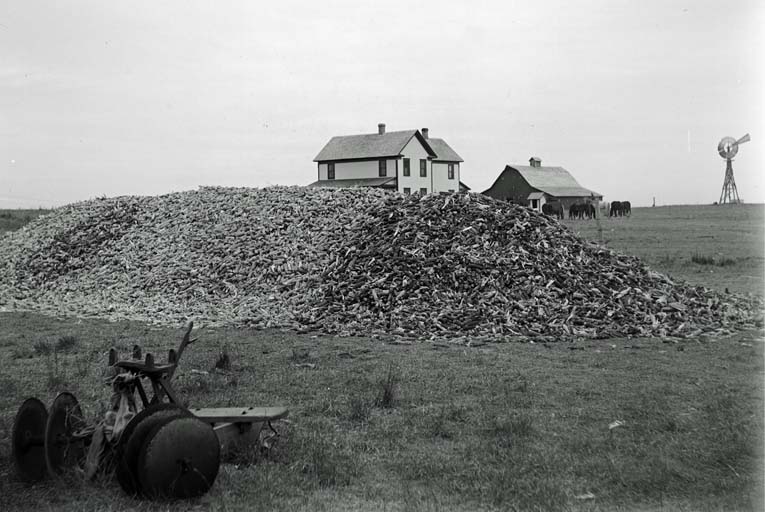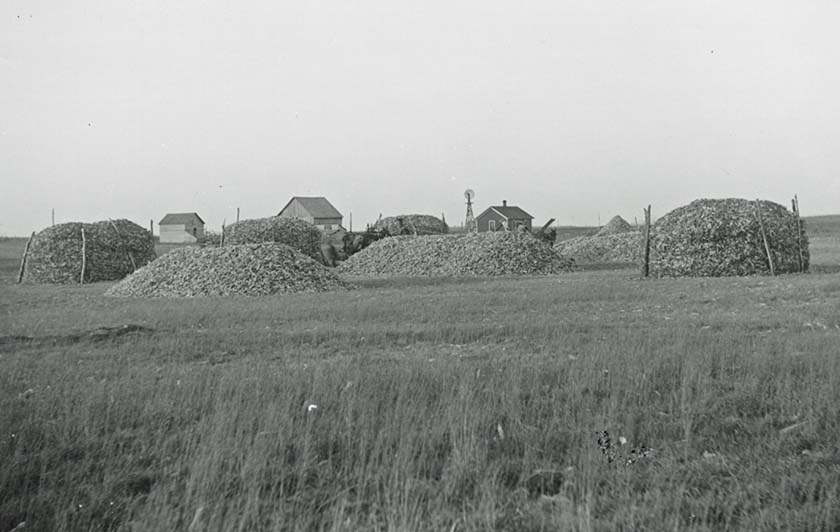They are cutting corn in my neighborhood. The 12 or 18 row combines are busy going up and down the fields, picking, husking, and shelling the grain off the cob. Watching the process now, it’s hard to imagine the labor-intensive work, all done by hand, in the early days of Edwards County.
I read in the old newspapers that once the haying was done, corn harvest took place in November and December. One early harvesting method used a corn binder to cut the corn stalks and bind them into shocks to stand in the field to dry. The ears could be stripped off by hand at that time, or they could be left in the shocks until the corn was needed that winter. Then the shocks were hauled into the barn to have the ears removed and the stalks used for feed and bedding.
The hard work of husking corn was made easier on the hands with the use of a metal hook or wooden peg. I paid a visit to the Edwards County Museum to look at their exhibit of these simple tools.

Husking could also be lightened by hosting a husking bee where friends and neighbors gathered to make a social event out of this chore.
The editor in the September 12, 1889 issue of Kinsley Mercury called for an “old fashioned quilting and corn husking sometime this fall and a dance at night….Have the Jones boys bring their fiddles and play ‘Possum up a gum stump, Cooney up a holler’ and let us dance in our shirt sleeves, with our pants in our boots, and kiss a girl for every red ear of corn we husk, and have a jug of cider and pumpkin pies for supper….”
That same issue, the Mercury passed on the report that the reward of a kiss for every red ear husked had the Sedgwick County boys “thinking of supplying the deficiencies of nature and adding a bucket of red paint to the paraphernalia to the corn husking bee this fall.”
Another method of harvesting was also used where a husker would walk the rows and break the ears loose from the shank. The husk was left attached while the corn was thrown into a horse-drawn wagon to be stored in the corn crib to dry.
I still had a hard time envisioning this procedure until I found a You Tube video that showed it being done. I encourage you to Google “Check out the speed of these corn huskers” and watch Illinois famer, Harlan Jacobson, go down a row of corn. The ear is cut with the right hand while the left hand holds the husks which remain on the stalk. Jacobson’s speed is truly amazing.

The early newspapers reveal how men were hired out to various farms to harvest corn. The November 6, 1902 issue of the Mercury reported that “A good man can make close on to three dollars a day.” That same week, the Kinsley Graphic broke that down into one half cent to two cents per bushel.
If you don’t think this is very much, consider this report from northeast Kansas. “When the pupils of a rural district in Nemaha county went to school the other morning, they found the school house locked and this placard tacked on the door: ‘Quit teaching and gone to husking corn – George Richmond.’ This tells the story of the shortage of school teachers in Kansas at the present time. Most any employment is more remunerative than school teaching.” (Mercury, Nov. 20, 1903)
A fast picker could pick 100 bushels a day. This translates into taking 75 days to harvest an 80-acre field. A simple year’s harvest might take the entire fall and winter.
In 1907, the Mercury reported that “Ovid Woods is the first to finish cornhusking. He finished last Thursday having employed three huskers for nearly three weeks. (November 15,1907)
Beginning in the 1920s, labor-saving machinery became available, but many farmers still continued to hand-harvest until after WWII.
By 1922 a nostalgia was already evident for old-fashioned corn husking. Local and state competitions were started. In 1924, eight hundred people traveled to Iowa to attend the first National Corn Husking Championship. By 1936 the national championship had grown until it attracted about 160,000 persons, the second largest sporting event in the country that year.
The contest’s goal was to harvest the most cleanly husked corn by weight in 80 minutes. Each husker was allotted a specified number of rows. Between each husker’s plot, 10 or more rows were husked out and the stalks were broken down so spectators could follow their favorites. There were penalties for leaving corn on the stalk and for leaving husks on the corn.
The average farmer could husk about 300 ears in 80 minutes. Fred Stanek of Iowa husked 2,000 ears that year and won with 80 pounds more corn than next competitor. He accumulating 24.3 bushels, and during the last 10 minutes of the contest, he threw 50 ears per minute.
The next year, Elmer Williams of Illinois husked 35.8 bushels, about 3,000 ears. His record was never beat. The onset of World War II ended the contest, and it was never started again.

